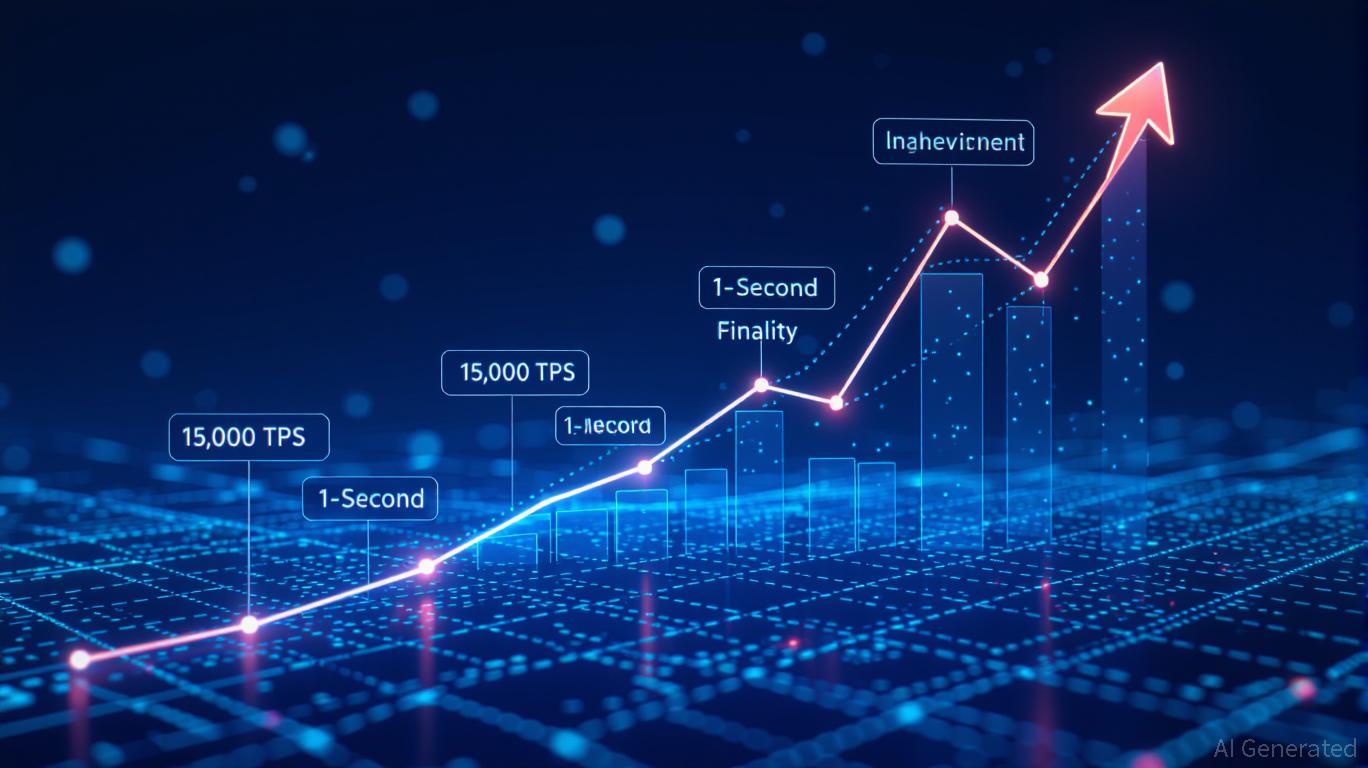ZK Atlas Enhancement: Accelerating Institutional Embrace in the Age of Blockchain
- ZK Atlas Upgrade addresses institutional blockchain scalability needs with 15,000 TPS and 1-second finality, aligning with trading/settlement demands. - ZKsync's deflationary tokenomics model ties token value to network usage, boosting institutional confidence through yield generation and scarcity. - Vitalik Buterin's endorsement and Ethereum compatibility lower adoption barriers, enabling seamless integration with existing institutional workflows. - Post-upgrade $300M+ daily trading volume and 20% token
Why Scalability Matters for Institutions
For institutions to embrace blockchain, three factors are essential: high throughput, cost-effectiveness, and compliance with regulations. Legacy layer-1 blockchains such as
This enhanced scalability is not just a technical achievement—it has economic implications. For institutional players, quicker transaction finality lowers counterparty risk, and reduced fees enhance profitability for frequent trading. A

Tokenomics: Capturing Value for Investors
While scalability is crucial, it alone does not guarantee institutional participation; the underlying tokenomics must also support long-term investment goals. ZKsync’s latest tokenomics overhaul, introduced by founder Alex Gluchowski, transforms the
This approach appeals to institutional investors, who favor assets with tangible utility and built-in scarcity. By directly linking token value to network activity, ZKsync adopts a model similar to Uniswap’s fee-sharing structure. Additionally, offering staking rewards introduces a yield component, which is especially attractive to institutions focused on capital efficiency. The
Vitalik Buterin’s Support and Ecosystem Integration
The impact of the ZK Atlas Upgrade goes beyond ZKsync itself. Ethereum co-founder Vitalik Buterin has publicly supported the initiative, acknowledging its contribution to Ethereum’s goal of building a scalable and privacy-focused blockchain ecosystem. Such endorsements are significant, as institutions often favor projects with strong developer communities and seamless integration with existing systems. ZKsync’s compatibility with Ethereum’s tools and smart contracts further simplifies adoption, allowing institutions to transfer assets without major changes to their processes, as detailed in a
Investment Considerations and Strategic Outlook
For investors, the ZK Atlas Upgrade is more than a technical update—it signals a new wave of institutional engagement. The synergy of scalability, deflationary tokenomics, and robust ecosystem backing creates a positive feedback loop: better performance draws more users, which increases revenue and enhances the token’s appeal. This is especially relevant as regulatory clarity around digital assets improves after 2024.
Nonetheless, there are still uncertainties. ZK technology remains in its early stages, and any shortcomings in implementation could affect outcomes. Furthermore, competition from other layer-2 solutions like
Summary
The ZK Atlas Upgrade marks a significant step forward in making blockchain suitable for institutional investment. By overcoming scalability hurdles and revamping tokenomics, ZKsync is establishing itself as a link between decentralized progress and institutional needs. With Vitalik Buterin’s endorsement and rising trading activity, the project demonstrates both technical strength and strategic alignment with the evolving crypto landscape. For investors, this presents a strong argument for including ZK-based platforms in a diversified digital asset strategy.
Disclaimer: The content of this article solely reflects the author's opinion and does not represent the platform in any capacity. This article is not intended to serve as a reference for making investment decisions.
You may also like
Aster News Today: Optimism Faces Prudence: ASTER Approaches $1.21 Following RSI CEO's 16% Stake Sale
- Aster (ASTER) rose 8% toward $1.21 as Binance-backed DEX hit $3T in cumulative trading volume. - RSI CEO sold 16% stake ($11M+), raising doubts despite Q2 revenue growth (19.7%) and EPS beat. - ASTER faces mixed signals: bullish triangle pattern vs. declining fees, 50% open interest drop, and stagnant adoption. - Analysts remain divided: RSI's 22% YTD gain contrasts with ASTER's uncertain breakout potential amid waning trader enthusiasm.

The ChainOpera AI Token Crash: An Urgent Warning for Cryptocurrency Projects Powered by AI
- ChainOpera AI's COAI token collapsed 96% in late 2025, exposing systemic risks in AI-driven DeFi ecosystems. - Centralized governance (10 wallets controlled 87.9% supply) and misaligned incentives exacerbated panic selling during crises. - Technical flaws included untested AI models with 270% increased vulnerabilities and inadequate smart contract security audits. - Regulatory shifts like the GENIUS Act compounded liquidity challenges, highlighting the need for compliance-ready AI crypto projects. - Inve

How large a portion of the AI data center surge will rely on renewable energy sources?
Amazon satellite network receives a new name — and no longer emphasizes its low-cost promise